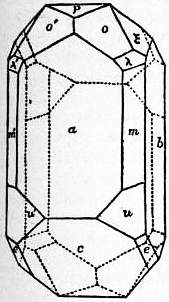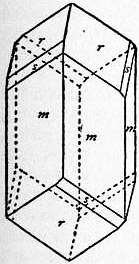Diopside
 From Britannica 11th Edition (1911)
From Britannica 11th Edition (1911) Diopside, an important member of the pyroxene group of rock-forming minerals. It is a calcium-magnesium metasilicate, CaMg(SiO3)2, and crystallizes in the monoclinic system. Usually some iron is present replacing magnesium, and when this predominates there is a passage to hedenbergite, CaFe(SiO3)2, a closely allied variety of monoclinic pyroxene. These are distinguished from augite by containing little or no aluminium. Diopside is colourless, white, pale green to dark green or nearly black in colour, the depth of the colour depending on the amount of iron present. The specific gravity and optical constants also vary with the chemical composition; the sp. gr. of diopside is 3.2, increasing to 3.6 in hedenbergite, and the angle of optical extinction in the plane of symmetry varies between 38° and 47° in the two extremes of the series. Crystals are usually prismatic in habit with a rectangular cross-section as shown in the figure: the angle between the prism faces m, parallel to which there are perfect cleavages, is 92° 50′.
 |
Several varieties, depending on differences in structure and chemical composition, have been distinguished, viz. coccolite (from κόκκος, a grain), a granular variety; salite or sahlite, from Sala in Sweden; malacolite; diallage; violane, a lamellar variety of a dark violet-blue colour; chrome-diopside, a bright green variety containing a small amount of chromium; and many others. Belonging to the same series with diopside and hedenbergite is a manganese pyroxene, known as schefierite, which has the composition (Ca, Mg) (Fe, Mn) (Si03)2.
Diopside is the characteristic pyroxene of metamorphic rocks, occurring especially in crystalline limestones, and often in association with garnet and epidote. It is also an essential constituent of some pyroxene-granites, diorites and a few other igneous rocks, but the characteristic pyroxene of this class of rocks is augite. Fine transparent crystals of a pale green colour occur, with crystals of yellowish-red garnet (hessonite) and chlorite, in veins traversing serpentine in the Ala valley near Turin in Piedmont: a crystal of this variety (“alalite”) is represented in the accompanying figure. These, as well as the long, transparent, bottle-green crystals from the Zillerthal in the Tyrol, have occasionally been cut as gem-stones. Good crystals have been found also at Achmatovsk near Zlatoust in the Urals, Traversella near Ivrea in Piedmont (“traversellite”), Nordmark in Sweden, Monroe in New York, Burgess in Lanark county, Ontario, and several other places: at Nordmark the large, rectangular black crystals occur with magnetite in the iron mines.
 |
↧ Download as ZWI file | Last modified: 11/17/2022 15:23:05 | 39 views
☰ Source: https://oldpedia.org/article/britannica11/Diopside | License: Public domain in the USA. Project Gutenberg License
 ZWI signed:
ZWI signed: KSF
KSF